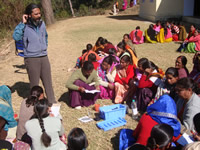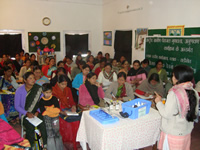- Skip to main content
- Skip to navigation
- Screen Reader Access
- Text Size
- Select Theme Default Theme Yellow Theme Pink Theme Blue Theme
- हिंदी में

Swajal ProjectGovernment Of Uttarakhand
- Home
- Brief Overview
- Water Quality Monitoring & Surveillance Program
Water Quality Monitoring & Surveillance Program
![]()
WQM&S Previously named as NRDWQM&S. The Goal of WQM&S Program (launched in February 2006) is to provide every rural person with adequate safe water for Drinking, Cooking and other Domestic basic needs on a sustainable basis. This basic need should meet minimum water quality standards and be readily and conveniently accessible at all time and in all situations.
Water supply for drinking and cooking is as per Bureau of Indian Standard (BIS) IS: 10500 and for other household and animal needs, the water should is of acceptable standard. The portability and reliability of Drinking Water quality standard both at the production (water treatment plant) as well as at the consumption point (household level) is done by the water Quality testing and sanitary inspection. Water is considered as safe if it is free from Physical & biological contamination and with in permissible limit of chemical contamination.


The main objectives of the program are as follows:
-
Decentralized monitoring and surveillance of all drinking water sources in the state by the community.
-
Institutionalization of community participation and involvement of Gram Panchayats for water quality monitoring and surveillance.
-
Generation of awareness among the rural masses about the water quality issues and problems related to water borne diseases by involving Zila Panchayat and Block Panchayat.
-
Capacity building of Panchayats to use the field test kit and take up full O&M responsibility for water quality monitoring of all drinking water sources in their respective PRI area.
HRD activities: Under HRD (Human Resource Development) trainings are being imparted to district, Block, and GP (gram Panchayat) level functionaries on use of Field Test Kit and water quality issue including water quality monitoring, health and related Diseases, sanitation and hygiene. No. of persons trained at different level are:
-
State level- 2.
-
District level: 4 persons per district.
-
Block level: 5 persons per block.
-
GP level: 5 persons per Gram Panchayat.
At GP level, training is imparted to school teacher, Health worker, Anganwadi workers, ASHA, GP member, Ex. army personnel, VWSC member and social worker. At all level number of persons trained per course is between 15 and 25.
Refresher training is also provided to one person from each Gram Panchayat.
IEC activities are being done to aware people about water quality issue like water quality monitoring, health and related Diseases, sanitation and hygiene. IEC includes inter personal communication, Audio-visual publicity, Hoarding and wall writing, slogan, picture frames, group meetings, street play, participatory rural appraisal and exhibitions
Monitoring And surveillance: water is considered safe if it is free from physical and bacteriological contamination and chemical contamination is with in permissible limit as per BIS: 10500 standards. Testing of water sample is done by both FTK (Field test Kit) and H2S Vials. Test for chemical contamination like pH, Total hardness, Alkalinity, Free chlorine, Nitrates, Turbidity, Fluoride, Chloride and iron can be done through FTK and bacteriological contamination through H2S vials.
The standards as per BIS: 10500 are Fluoride<1.5 mg/l, Iron<1 mg/l, Nitrate<45 mg/l , pH between 6.5 to 8.5, E-Coli –Absent, Calcium ( as Ca) <200 mg/l, Turbidity <10 NTU, Alkalinity <600 mg/l.
One field test kit is provided to each GP. In addition, demo kits are also provided at District (03 Nos.) and Block level (02 Nos.) for training purpose.
In such cases where GP is large an additional kit is provided. Refills of Field Test Kits are also provided to replace expired chemicals.
FUNDING: The fund for the implementation of the Program is released by the Government of India to the SWSM. 100% funding for IEC activities, HRD activities, strengthening of district level laboratories, procurement of field test kits, travel &transport cost, data reporting cost, stationery cost, honorarium to district level surveillance coordinators, water testing, documentation and data entry costs to the States for strengthening water quality monitoring facilities as per approved norms for water quality monitoring and surveillance.
REPORTING: Testing of water sample is done once in a year for chemical contamination and twice for bacteriological contamination. Results obtained through FTKs are preliminary results. Data generated from the household levels or laboratories reported in MIS developed by the NIC- DDWS. ASHA of NRHM is responsible for the community action on prevention of water and sanitation borne diseases.




